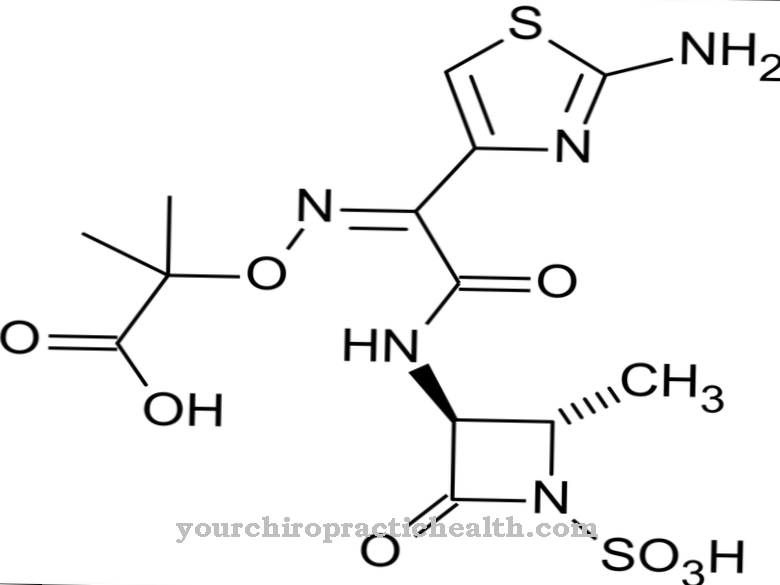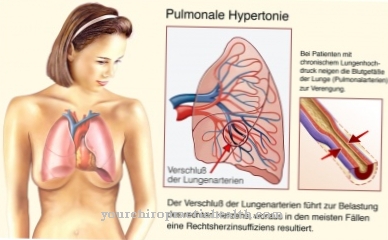Pethidine is a fully synthetic opioid. It is used for severe to very severe pain, such as can occur after accidents or operations.
What is pethidine?

Pethidine is the oldest fully synthetic opioid. It was first synthesized in 1937. In Germany it is gradually being replaced by younger preparations, but it is still considered one of the most important strong analgesics worldwide.
The structure of pethidine is a simplified replica of the atropine molecule. It is produced in a two-step synthesis. In medicinal products, pethidine is a white, crystalline powder that is easily soluble in water. It is considered a narcotic drug, is only available as such by prescription and is subject to strict controls. Pethidine is commercially available as a solution for injection or in the form of tablets, and suppositories are also available.
Pharmacological effect
Since pethidine belongs to the group of opioid pain relievers, its effects are exerted on the so-called opioid receptors in the brain. The body's own messenger substances are imitated by the active substance. By binding to the receptors, these inhibit the transmission of pain sensation and pain perception.
Pethidine ensures that even very severe pain is perceived by the patient as less extreme than it actually is. Accordingly, pethidine has a similar effect to morphine, but is five times weaker and therefore also has a lower mood-lifting effect.
Pethidine has an analgesic, antitussive, spasmolytic, respiratory depressive and sedative effect. It helps lower blood pressure and increase heart rate. Administration is possible orally, rectally, intramuscularly and intravenously.
Medical application & use
Pethidine is used in the treatment of moderate to very severe acute and persistent pain as soon as non-opioid painkillers or even weak opioids show no effect. It is used, among other things, for pain caused by tumors, for pain caused by a myocardial infarction or as part of postoperative analgesia. It is also effective for post-operative tremors. Pethidine is also used in the treatment of colic and pancreatitis (acute or chronic inflammation of the pancreas).
Since pethidine forms the active metabolite norphetidine, it is not suitable for long-term therapy because norphetidine can lead to seizures. The duration of action of pethidine is around 2 to 4 hours. In the case of intravenous administration, the maximum effect is reached after about 3 to 10 minutes, with intramuscular administration the effect reaches its peak after about 20 to 40 minutes.
Pethidine is contraindicated in cases of hypersensitivity reactions to the active ingredient, respiratory insufficiency, acute bronchial asthma, certain cardiac arrhythmias, increased intracranial pressure, convulsions, diabetic acidosis, alcoholism and drug addiction, severe liver diseases or Addison's disease (primary adrenal insufficiency).
Also not advisable in the case of low blood pressure, impaired kidney function, malfunction of the thyroid gland (over- or under-function) and diseases of the urethra.
In the first three months of pregnancy, pethidine must also not be taken, although it can be used as a pain reliever in the lowest possible dose during childbirth. Pethidine is not suitable for use in children and adolescents under the age of 16.
You can find your medication here
➔ Medicines for painRisks & side effects
The side effects that frequently occur with the administration of pethidine include a drop in blood pressure, respiratory dysfunction, palpitations or slowing of the heartbeat, increase in intracranial pressure, dizziness, drowsiness, change in mood, perception disorders, delusions and states of excitement.
If pethidine is injected into the vein very quickly, it can also cause bronchial cramps, nausea and vomiting, hiccups and constriction of the pupils. Long-term use of pethidine can result in constipation or difficulty emptying the bladder.
Cramps in the biliary tract, impaired function of the kidneys or allergic hypersensitivity reactions can also occur. If pethidine is injected into the vein, red wheals and pain can develop along the respective blood vessel.
If pethidine is taken at the same time as anti-epileptic drugs or pain relievers, there may also be undesirable interactions, such as a weakening or intensification of the effect of pethidine or the other drug.
























.jpg)



